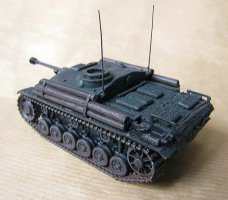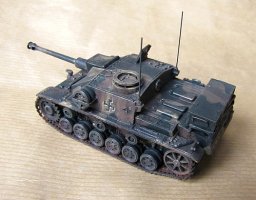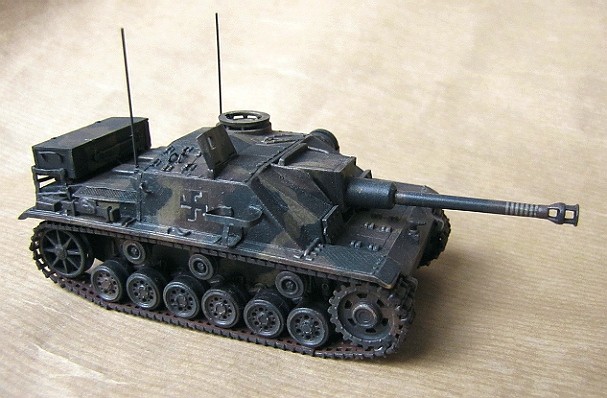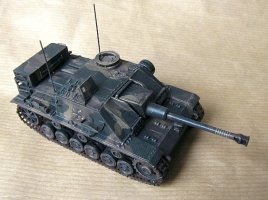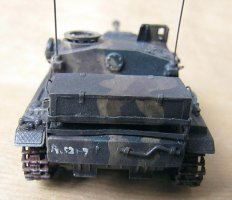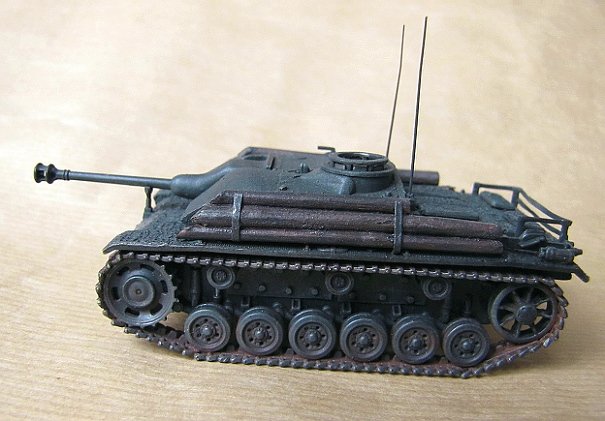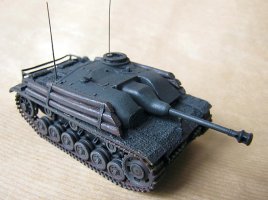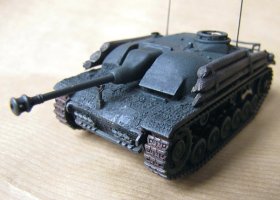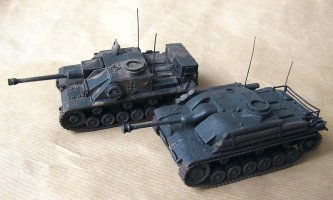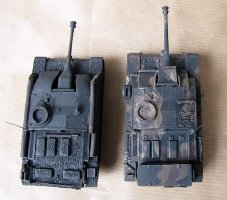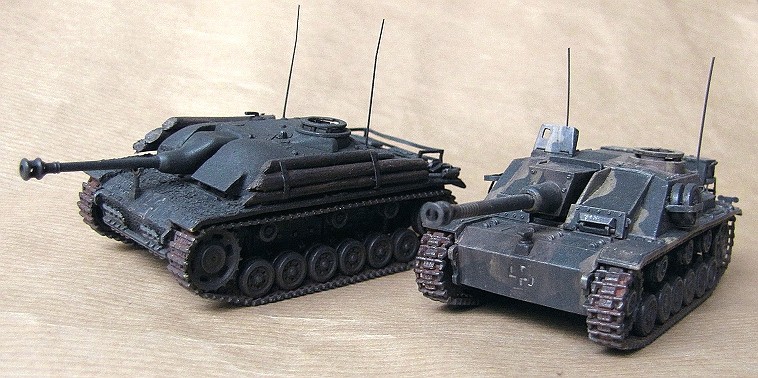 Historical background The Finns received 59 pieces of StuG 40G/StuG IIIG assault guns in two batches from Germany during 1943-44, and they proved to be, arguably, the single most important factor in bringing the Russian summer offensive of 1944 to a halt, scoring 87 kills. The StuG, or "Sturmi" as it was called in Finland remained in service until the 1960´s, and there are still almost 30 examples around the country in various states of preservation. There is an excellent, excellent web page by Andreas Lärka about the subject in http://www.andreaslarka.net/assaultguns.html. There you can find any relevant information about the StuGs in Finnish service, the modifications made by the Finns, individual battle histories of each assault gun and extensive photographic material about the surviving vehicles. The kits There currently are two fine kits on the market depicting the Stug 40/IIIG in the 1/72 scale. Revell represents a late model with a "topfblende/saukopf" mantlet, a deflecting cast in front of the cupola, a remote controlled MG and other late features such as the changed opening direction of the loaders hatch and a port for the close defence weapon. Italeri has re-released the older ESCI version of the vehicle, which represents an earlier type equipped with the bolted, boxy gun mantlet, high MG shield and schürtzen plates. Neither kit has bolted-on nose armour or a stowage rack on the engine deck, which were features present on many Finnish StuGs of the earlier batch. In the box both kits look very good, but of course the age of the Italeri kit shows, making it the less appealing choice. Especially the relative softness of some surface details (engine deck in particular), crudeness of the molding in some areas (molded-on tools, lack of detail on the hull underside and wheel backsides) and the amount of ejector marks are a slight turn off. Still the overall appearance of the Italeri kit is quite pleasing, and it catches the appearance and dimensions of the real vehicle well. It also enjoys a wealth of stowage like jerry cans and buckets, which can be used with other kits, too, if so wished. The Revell kit, for its part, is very refined and leaves no room for severe criticism. In fact, it can be considered one of the best efforts ever in the 1/72 scale. I would, however, maintain that it has a gun barrel, which is a bit on the thin side. Both kits have hard plastic tracks. Finnish modifications The Finns modified their StuGs rather heavily both during the war (two different phases of upgrading) and afterwards. In retrospect it is difficult to know which modifications were applied to each vehicle, since the changes and re-equipment were carried out variedly and did not reach all vehicles during the war at all. In addition, many vehicles were destroyed in the war or later and some of the mods were deleted after the war and others were applied. The line of modifications is thoroughly explained in Lärka’s site, and it is highly advisable to visit it and study the subject before deciding on the kit and how to build it. The most important and visible Finnish add-ons were the build-up of concrete around the drivers and loaders positions, additional armour plates between the top of the road wheels and top run of the tracks, protective logs on the sides of the vehicles, a big wooden stowage box on the engine deck, relocation of the spare wheels to the sides of the vehicle, and the replacing of the loaders MG with a Russian DT gun. It is important to pay attention to the fact that the first batch vehicles in Finland (30 pieces in 1943) were mainly the boxy mantlet type without zimmerit, while the second batch (29 pieces in 1994) were almost exclusively equipped with the cast "topfblende/saukopf" mantlet and zimmerit coating. Most of the latter also sported all steel return rollers, which neither of the kits provide. These starting points suggest that the Italeri kit is far better suited to represent a vehicle of the earlier batch, while the Revell kit is clearly more suitable to be used as the basis of the 1944 batch "Sturmi". Building I have both kits and wanted, evidently, to finish them both in Finnish colours. To build two Finnish StuGs would be more fun if they were as dissimilar as possible. One option would have been to build the other one as a post-war variant, but since I’m more interested in the WWII era, I decided to have a go with one wartime model from each arrival batch with different modifications. To properly depict an operational vehicle during the fights of ’44 is difficult and requires a great deal of guessing. Building the Italeri, batch 1943
There are no major errors in the Italeri kit, but some areas require certain adjusting or refining. One of the most prominent mistakes of the kit is the gun mantlet, which tapers forwards, when it should be perfectly even. Filing helps here. The mantlet also misses panel lines and has an overly thick base plate, which I corrected. On the aft, the five ventilation louvres are molded solid on the engine deck, and it might be a good idea to scribe some separating grooves, although these can for the most part be covered with stowage. The Finns did not use side skirts, so they are omitted and locator holes for the hangers need to be filled. The Finnish StuGs did not have smoke launchers, which in this case is a welcome thing, since Italeri represents them very badly, molded directly and clumsily on the hull. So I cut and sanded them off completely. Also, Italeri portrays the return rollers as single pieces when they should be doubles. This had to be corrected by scoring circumferential grooves to the middle. The wheels and tracks are simplistic, but have adequate details on the right spots, so they look almost spot-on on the finished model. Note that the length runs are few links too long and must be cut shorter as the instructions show. The Finnish type stowage box on the engine deck was made of plastic beams glued together, with corner enforcements and hinges made of foil and handles made of wire. The shape is simplified, as the real box is slightly L-shaped with the long flat side facing upwards. The box is embedded in a rack made of foil and a two-man saw taken from Revell’s T-34 kit is glued to its side. The air intakes of the engine were covered with a fine mesh (cut from a metal mesh coffee filter) and framed with thin paper strips. Finally, the loaders MG shield was thinned down and added with some details – no MG is planted as I did not have an appropriate piece. The build was completed with spare wheel holders on the sides made of copper band, some handles and lift rings made of metal wire plus antennas and an engine start crank made of stretched sprue. Building the Revell, batch 1944
The Revell kit would have been almost an out of-the-box build had it not required zimmerit and several Finnish modifications. I started by adding the reinforcing concrete bulges around the drivers and loaders positions, forming their basic shape of plastic beams and putty and then sanding them to form. I also swapped the drivers visors between the two kits, because with the concrete and an extra armour shield made of plastic sheet on top of the visor it would not be visible with this model. Instead, I wanted to use the more accurate Revell piece on the Italeri kit where its finesse would be more appreciated. It might be a good idea to cover the close defence grenade launcher port with a plastic disc, as Finns did not have this equipment, but the detail is so minor that I did not think the plugging was necessary. However, I did plug the MG opening on the gun mantlet. The next step was to plug the schürtzen holders installation grooves on the fenders and the fender undersides to prevent seeing through. After that it was time for the zimmerit. The Finnish StuGs carried two patterns of zimmerit, neither of which was possible to emulate with my tried method of grooving the glue softened plastic with a jeweller’s screwdriver. Therefore it had to be done by adding putty on the surfaces and "stamping" the pattern with a tool I made of a plastic beam. This is a simple, rectangular piece with criss-crossing grooves filed on its end, producing a "negative" waffle pattern. I followed a building order where the hull bottom was completed (with the wheels and tracks assembled and painted), and where the mating of the likewise prepared hull top took place after this sequence. The additional armour plates on the lower hull sides were cut from plastic sheet and the bolt heads were simulated with slices of thin plastic rod. The loaders MG was completely left off, but I added a small stand on the roof as for the Russian DT gun. The stowage rack on the engine deck was made of lead foil. The protective logs on the sides are twigs attached to each other with a J-shaped copper band. The detailing also included air-intake covers made of metal mesh framed with paper strips plus an engine start crank and antennas made of sprue. I also planted the other one of the Italeri kits tail lights on the Revell kit for reasons of uniformity, although it is not quite accurate. The build of the Revell kit as such was very straightforward and free of trouble, the only surprise being the loose fit of the sprocket wheels to the hull. This was of course easy to fix. All other challenges stemmed from the application of the Finnish modifications. None of these, either, were particularly troublesome, although the application of zimmerit, adding concrete reinforcements and the like required a fair amount of care and concentration. Technically the conversions were not difficult to carry out, so there was no reason to avoid doing them. Painting and marking The StuGs were delivered to Finland in their original German colour scheme. In Finland the 1943 batch received the then prevailing, hard edged three-tone camouflage of moss green, sand brown and pale "creamish" grey, while the 1944 batch were hastily and rather crudely oversprayed with a dark green paint, with the original colour partially showing through. I reproduced these schemes with Tamiya acrylic paints (XF-11, XF-52 and XF-57). I painted the 1943 variant carefully with brush, but the 1944 model received a casual, green overspray on a yellow base. The markings were "hakaristi" swastikas* and white individual registration numbers carrying the Ps.531 code unique to StuGs and followed by a one or two-digit code to mark the individual vehicle. Because there are no commonly available Finnish decals, I had to print my own. The code numbers are crudely hand painted on the 1943 model and completely absent on the 1944 model. With individual markings one has to be specific, as almost all Finnish "Sturmi"s differed from each other detail-wise. I chose my 1943 model to represent the Ps.531-9 with 7 kills, dubbed "Toini", which was presumably destroyed after the war in target practice (okay, I admit that the camo pattern is copied from another, remaining vehicle). There is not very much material on the later 1944 models in action, and only one vehicle is preserved in the modified outfit today. I played a guessing game, deciding that my model would portray Ps.531-51, a vehicle which has likewise been destroyed, preventing a direct comparison and error spotting. The models were finished with drybrushing, a black wash and a satin varnish coating toned with grey. Finally, some pastel chalk was applied around the tracks, (rust shades), wheels (earth shades) and exhausts (black). Conclusions The StuG III was such a remarkably important vehicle in the European theatres of WWII that it is surprising that for a long time there were no decent kits available representing it, apart from the Airfix kit dated in 1963. Well, now we are lucky to have two, and both of them are very nice indeed. Especially the Revell kit is a work of art and demonstrates finely the current technological standards. In comparison the Italeri product suffers somewhat, but it is still a decently accurate and easily assembled kit in its own right. I quite enjoyed building two similar but slightly differing kits at the same time as this allowed part comparison, swapping and enhancing, which in my opinion contributed to a more uniform appearance of the models. * Please, note that the Finnish swastika emblems are not related to nazism, but they were ancient symbols of good luck and used by the Finnish air force and army as early as 1918. |
